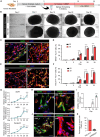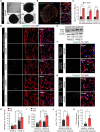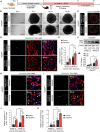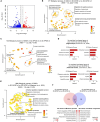Modeling APOE ε4 familial Alzheimer's disease in directly converted 3D brain organoids
- PMID: 39185458
- PMCID: PMC11341472
- DOI: 10.3389/fnagi.2024.1435445
Modeling APOE ε4 familial Alzheimer's disease in directly converted 3D brain organoids
Abstract
Brain organoids have become a valuable tool for studying human brain development, disease modeling, and drug testing. However, generating brain organoids with mature neurons is time-intensive and often incomplete, limiting their utility in studying age-related neurodegenerative diseases such as Alzheimer's disease (AD). Here, we report the generation of 3D brain organoids from human fibroblasts through direct reprogramming, with simplicity, efficiency, and reduced variability. We also demonstrate that induced brain organoids from APOE ε4 AD patient fibroblasts capture some disease-specific features and pathologies associated with APOE ε4 AD. Moreover, APOE ε4-induced brain organoids with mutant APP overexpression faithfully recapitulate the acceleration of AD-related pathologies, providing a more physiologically relevant and patient-specific model of familial AD. Importantly, transcriptome analysis reveals that gene sets specific to APOE ε4 patient-induced brain organoids are highly similar to those of APOE ε4 post-mortem AD brains. Overall, induced brain organoids from direct reprogramming offer a promising approach for more efficient and controlled studies of neurodegenerative disease modeling.
Keywords: 3D modeling; Alzheimer’s disease; amyloid-beta; apolipoprotein E; direct conversion.
Copyright © 2024 Kim, Kim, Cho, An, Kang, Kim and Kim.
Conflict of interest statement
The authors declare that the research was conducted in the absence of any commercial or financial relationships that could be construed as a potential conflict of interest.
Figures




Similar articles
-
APOE ε4-dependent effects on the early amyloid pathology in induced neurons of patients with Alzheimer's disease.Transl Neurodegener. 2022 Oct 25;11(1):45. doi: 10.1186/s40035-022-00319-9. Transl Neurodegener. 2022. PMID: 36284363 Free PMC article.
-
Culture Variabilities of Human iPSC-Derived Cerebral Organoids Are a Major Issue for the Modelling of Phenotypes Observed in Alzheimer's Disease.Stem Cell Rev Rep. 2022 Feb;18(2):718-731. doi: 10.1007/s12015-021-10147-5. Epub 2021 Mar 16. Stem Cell Rev Rep. 2022. PMID: 33725267
-
Association of liver function markers and apolipoprotein E ε4 with pathogenesis and cognitive decline in Alzheimer's disease.Front Aging Neurosci. 2024 Jul 24;16:1411466. doi: 10.3389/fnagi.2024.1411466. eCollection 2024. Front Aging Neurosci. 2024. PMID: 39114318 Free PMC article.
-
ApoE4 reduction: An emerging and promising therapeutic strategy for Alzheimer's disease.Neurobiol Aging. 2022 Jul;115:20-28. doi: 10.1016/j.neurobiolaging.2022.03.011. Epub 2022 Mar 22. Neurobiol Aging. 2022. PMID: 35453035 Free PMC article. Review.
-
Modeling Alzheimer's disease using human cell derived brain organoids and 3D models.Front Neurosci. 2024 Aug 1;18:1434945. doi: 10.3389/fnins.2024.1434945. eCollection 2024. Front Neurosci. 2024. PMID: 39156632 Free PMC article. Review.
Cited by
-
The translational power of Alzheimer's-based organoid models in personalized medicine: an integrated biological and digital approach embodying patient clinical history.Front Cell Neurosci. 2025 May 15;19:1553642. doi: 10.3389/fncel.2025.1553642. eCollection 2025. Front Cell Neurosci. 2025. PMID: 40443709 Free PMC article. Review.
-
Catalpol promotes the generation of cerebral organoids with oRGs through activation of STAT3 signaling.Bioeng Transl Med. 2024 Dec 29;10(3):e10746. doi: 10.1002/btm2.10746. eCollection 2025 May. Bioeng Transl Med. 2024. PMID: 40385540 Free PMC article.
-
Parkinson's Disease Modeling Using Directly Converted 3D Induced Dopaminergic Neuron Organoids and Assembloids.Adv Sci (Weinh). 2025 Apr;12(14):e2412548. doi: 10.1002/advs.202412548. Epub 2025 Feb 18. Adv Sci (Weinh). 2025. PMID: 39965129 Free PMC article.
-
Epigenetic Dynamics in Reprogramming to Dopaminergic Neurons for Parkinson's Disease.Adv Sci (Weinh). 2024 Nov;11(41):e2403105. doi: 10.1002/advs.202403105. Epub 2024 Sep 16. Adv Sci (Weinh). 2024. PMID: 39279468 Free PMC article.
References
LinkOut - more resources
Full Text Sources
Miscellaneous

